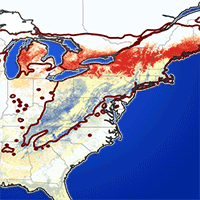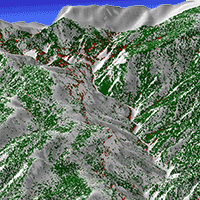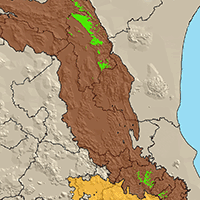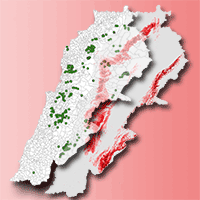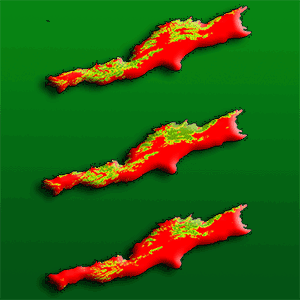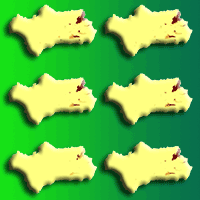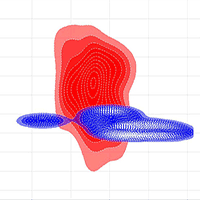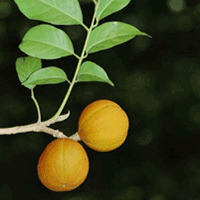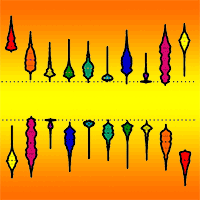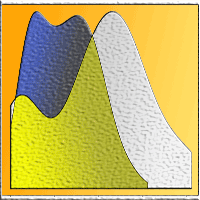The hemlock woolly adelgid (Adelges tsugae Annand - HWA) is invasive in eastern North America where it causes extensive mortality to hemlock communities. The future of these communities under projected climate change is an issue of landscape ecological interest and speculation. We employed the MaxEnt algorithm with the random subset feature selection algorithm (RSFSA) in creating HWA niche models. Final models were ensembles of 12 statistically best models with six predictors each. Out of 119 climatic, topographic, and soil variables, 42 were used in at least one final model. Soil features, followed by climate and topographic features, were most common in selected models. The three most important variables among all models were November potential evapotranspiration, slope, and percent Ochrepts soil. The potential distributions of HWA within eastern North America were projected under historical and four future climate scenarios for 2050 and 2070 under low and high CO2 emissions. The mean of the minimum values for the minimum temperature of the coldest month from the 12 MaxEnt model projections in eastern North America was -15.8°C. This value was close to -15°C, the extreme minimum temperature found for both HWA occurrence points and previously reported HWA cold temperature limits. These results indicate that HWA may be close to equilibrium distribution in eastern North America under current climate. We also reverse-casted the eastern North American MaxEnt model back onto the HWA native ranges in eastern Asia and western North America. The projections match best with native ranges in Asian islands, such as Japan, and the Cascade Mountains in western North America. Statistically significant HWA range shifts of 221-468 km northwards and 110-164 km eastwards were projected by the 12 models for 2050-2070. The 2070 high CO2 emission scenario models projects HWA suitability throughout most of the northern range of eastern hemlock.
Keywords
, , , , ,
Citation
Kantola T, Tracy JL, Lyytikäinen-Saarenmaa P, Saarenmaa H, Coulson RN, Trabucco A, Holopainen M (2019). Hemlock woolly adelgid niche models from the invasive eastern North American range with projections to native ranges and future climates. iForest 12: 149-159. - doi: 10.3832/ifor2883-012
Academic Editor
Massimo Faccoli
Paper history
Received: Jun 05, 2018
Accepted: Jan 26, 2019
First online: Mar 04, 2019
Publication Date: Apr 30, 2019
Publication Time: 1.23 months
© SISEF - The Italian Society of Silviculture and Forest Ecology 2019
Open Access
This article is distributed under the terms of the Creative Commons Attribution-Non Commercial 4.0 International (https://creativecommons.org/licenses/by-nc/4.0/), which permits unrestricted use, distribution, and reproduction in any medium, provided you give appropriate credit to the original author(s) and the source, provide a link to the Creative Commons license, and indicate if changes were made.

Breakdown by View Type
(Waiting for server response...)
Article Usage
Total Article Views: 47925
(from publication date up to now)
Breakdown by View Type
HTML Page Views: 38277
Abstract Page Views: 5208
PDF Downloads: 3550
Citation/Reference Downloads: 5
XML Downloads: 885
Web Metrics
Days since publication: 2477
Overall contacts: 47925
Avg. contacts per week: 135.44
Article Citations
Article citations are based on data periodically collected from the Clarivate Web of Science web site
(last update: Mar 2025)
Total number of cites (since 2019): 15
Average cites per year: 2.14
Publication Metrics
by Dimensions ©
Articles citing this article
List of the papers citing this article based on CrossRef Cited-by.
(1)
Bale JS, Masters GJ, Hodkinson ID, Awmack C, Bezemer TM, Brown VK, Butterfield J, Buse A, Coulson JC, Farrar J, Good JE, Harrington R, Hartley S, Jones TH, Lindroth RL, Press MC, Symrnioudis I, Watt AD, Whittaker JB (2002)Herbivory in global climate change research: direct effects of rising temperature on insect herbivores. Global Change Biology 8 (1): 1-16.
CrossRef |
Gscholar
(2)
Björkman C, Bylund H, Klapwijk MJ, Kollberg I, Schroeder M (2011)Insect pests in future forests: more severe problems? Forests 2: 474-485.
CrossRef |
Gscholar
(3)
Bradley BA, Olsson AD, Wang O, Dickson BG, Pelech L, Sesnie SE, Zachmann LJ (2012)Species detection
vs. habitat suitability: are we biasing habitat suitability models with remotely sensed data? Ecological modeling 244: 57-64.
CrossRef |
Gscholar
(4)
Burns RM, Honkala BH (1990)Silvics of North America: Volume 1, Conifers. USDA Forest Service, Agriculture Handbook 654, Washington, DC, USA, pp. 604-611.
Online |
Gscholar
(5)
Butin E, Porter AH, Elkinton J (2005)Adaptation during biological invasions and the case of Adelges tsugae. Evolutionary Ecology Research 7: 887-900.
Online |
Gscholar
(6)
Dormann CF, Elith J, Bacher S, Buchmann C, Carl G, Carré G, Marquéz JR, Gruber B, Lafourcade B, Leitão PJ, Münkemüller T (2013)Collinearity: a review of methods to deal with it and a simulation study evaluating their performance. Ecography 36: 27-46.
CrossRef |
Gscholar
(7)
Dukes JS, Pontius J, Orwig D, Garnas JR, Rodgers VL, Brazee N, Cooke B, Theoharides KA, Stange EE, Harrington R, Ehrefield J, Gurewitch J, Lerdau M, Stinson K, Wick R, Ayres M (2009)Responses of insect pests, pathogens, and invasive plant species to climate change in the forests of northeastern North America: what can we predict? Canadian Journal of Forest Research 39: 231-248.
CrossRef |
Gscholar
(8)
Ehrlén J, Morris WF (2015)Predicting changes in the distribution and abundance of species under environmental change. Ecology Letters 18 (3): 303-314.
CrossRef |
Gscholar
(9)
Elith J, Kearney M, Phillips S (2010)The art of modelling range-shifting species. Methods Ecology and Evolution 1: 330-342.
CrossRef |
Gscholar
(10)
Ellison A, Orwig D, Fitzpatrick M, Preisser E (2018)The past, present, and future of the hemlock woolly adelgid (
Adelges tsugae) and its ecological interactions with eastern hemlock (
Tsuga canadensis) forests. Insects 9 (4): 172.
CrossRef |
Gscholar
(11)
Farjon A (1990)Pinaceae: drawings and descriptions of the genera
Abies,
Cedrus, Pseudolarix, Keteleeria, Nothotsuga, Tsuga, Cathaya, Pseudotsuga, Larix and
Picea. Koeltz Scientific Books, Königstein, Germany, pp. 330.
Online |
Gscholar
(12)
Fitzpatrick MC, Preisser EL, Porter A, Elkinton J, Ellison AM (2012)Modeling range dynamics in heterogeneous landscapes: invasion of the hemlock woolly adelgid in eastern North America. Ecological applications 22: 472-486.
CrossRef |
Gscholar
(13)
Freeman EA, Moisen G (2008)PresenceAbsence: an R package for presence absence analysis. Journal of Statistical Software 23 (11): 1-31. -
CrossRef |
Gscholar
(14)
Fitzpatrick MC, Weltzin JF, Sanders NJ, Dunn RR (2007)The biogeography of prediction error: why does the introduced range of the fire ant overâÂÂpredict its native range? Global Ecology and Biogeography 16 (1): 24-33.
CrossRef |
Gscholar
(15)
Ford CR, Elliott KJ, Clinton BD, Kloeppel BD, Vose JM (2012)Forest dynamics following eastern hemlock mortality in the Southern Appalachians. Oikos 121 (4): 523-536.
CrossRef |
Gscholar
(16)
Hastings JM, Potter KM, Koch FH, Megalos M, Jetton RM (2017)Prioritizing conservation seed banking locations for imperiled hemlock species using multi-attribute frontier mapping. New forests 48 (2): 301-316.
CrossRef |
Gscholar
(17)
Haughian SR, Burton PJ, Taylor SW, Curry C (2012)Expected effects of climate change on forest disturbance regimes in British Columbia. Journal of Ecosystems and Management 13 (1): 1-24.
Online |
Gscholar
(18)
Havill NP, Montgomery ME, Yu GY, Shiyake S, Caccone A (2006)Mitochondrial DNA from hemlock woolly adelgid (hemiptera: Adelgidae) suggests cryptic speciation and pinpoints the source of the introduction to eastern North America. Annals of the Entomological Society of America 99: 195-203.
CrossRef |
Gscholar
(19)
Havill NP, Vieira LC, Salom SM (2014)Biology and control of hemlock woolly adelgid. FHTET-2014-05, USDA Forest Service, Forest Health Technology Enterprise Team, Morgantown, WV, USA, pp. 21.
Gscholar
(20)
Havill NP, Shiyake S, Lamb Galloway A, Foottit RG, Yu G, Paradis A, Elkinton J, Montgomery ME, Sano M, Caccone A (2016)Ancient and modern colonization of North America by hemlock woolly adelgid,
Adelges tsugae (Hemiptera: Adelgidae), an invasive insect from East Asia. Molecular Ecology 25: 2065-2080.
CrossRef |
Gscholar
(21)
Heikkinen RK, Marmion M, Luoto M (2012)Does the interpolation accuracy of species distribution models come at the expense of transferability? Ecography 35: 276-288.
CrossRef |
Gscholar
(22)
Hijmans RJ, Phillips S, Leathwick J, Elith J (2011)Package “dismo”: species distribution modeling. Web site.
Online |
Gscholar
(23)
Iverson LR, Prasad AM, Matthews SN, Peters M (2008)Estimating potential habitat for 134 eastern US tree species under six climate scenarios. Forest Ecology and Management 254 (3): 390-406.
CrossRef |
Gscholar
(24)
Iverson LR, Prasad AM, Matthews SN, Peters MP (2011)Lessons learned while integrating habitat, dispersal, disturbance, and life-history traits into species habitat models under climate change. Ecosystems 14 (6): 1005-1020.
CrossRef |
Gscholar
(25)
Jiménez-Valverde A, Decae AE, Arnedo MA (2011)Environmental suitability of new reported localities of the funnelweb spider
Macrothele calpeiana: an assessment using potential distribution modelling with presence-only techniques. Journal of Biogeography 38: 1213-1223.
CrossRef |
Gscholar
(26)
Kantola T, Lyytikäinen-Saarenmaa P, Coulson RN, Strauch S, Tchakerian MD, Holopainen M, Saarenmaa H, Streett DA (2014)Spatial distribution of hemlock woolly adelgid induced hemlock mortality in the Southern Appalachians. Open Journal of Forestry 4: 492-506.
CrossRef |
Gscholar
(27)
Kulhanek SA, Leung B, Ricciardi A (2011)Using ecological niche models to predict the abundance and impact of invasive species: Application to the common carp. Ecological applications 21: 203-213.
CrossRef |
Gscholar
(28)
Lemoine NP, Burkepile DE (2012)Temperature-induced mismatches between consumption and metabolism reduce consumer fitness. Ecology 93: 2483-2489.
CrossRef |
Gscholar
(29)
Leppanen C, Simberloff D (2017)Implications of early production in an invasive forest pest. Agricultural and Forest Entomology 19 (2): 217-224.
CrossRef |
Gscholar
(30)
Liang L, Clark JT, Kong N, Rieske LK, Fei SL (2014)Spatial analysis facilitates invasive species risk assessment. Forest Ecology and Management 315: 22-29.
CrossRef |
Gscholar
(31)
Liu C, White M, Newell G (2013)Selecting thresholds for the prediction of species occurrence with presence-only data. Journal of Biogeography 40: 778-789.
CrossRef |
Gscholar
(32)
Mausel DL, Van Driesche RG, Elkinton JS (2011)Comparative cold tolerance and climate matching of coastal and inland
Laricobius nigrinus (Coleoptera: Derodontidae), a biological control agent of hemlock woolly adelgid. Biological Control 58: 96-102.
CrossRef |
Gscholar
(33)
McAvoy TJ, Régnière J, St-Amant R, Schneeberger NF, Salom SM (2017)Mortality and recovery of hemlock woolly adelgid (
Adelges tsugae) in response to winter temperatures and predictions for the future. Forests 8 (12): 497.
CrossRef |
Gscholar
(34)
McClure M (1997)Biological control in native and introduced habitats: Lessons learned from the sap-feeding guilds on hemlock and pine. In: “Ecological interactions and biological control” (Ragsdale AD, Nyvall R eds). Westview Press, Boulder, CO, USA, pp. 31-52.
Gscholar
(35)
McClure MS, Cheah CAJ (1999)Reshaping the ecology of invading populations of hemlock woolly adelgid,
Adelges tsugae (Homoptera: Adelgidae), in eastern North America. Biological Invasions 1 (2-3): 247-254.
CrossRef |
Gscholar
(36)
McClure MS, Salom SM, Shields KS (2001)Hemlock wooly adelgid. USDA Forest Service, Forest Health Technology Enterprise Team, Morgantown, WV, USA, pp. 19.
Gscholar
(37)
Mech AM (2015)Abiotic and biotic factors influencing eastern hemlock (
Tsuga canadensis) health and hemlock woolly adelgid (
Adelges tsugae) success in the Southern Appalachian Mountains. Doctoral dissertation, The University of Georgia Athens, GA, USA, pp. 114.
Online |
Gscholar
(38)
Menke SB, Holway DA, Fisher RN, Jetz W (2009)Characterizing and predicting species distributions across environments and scales: Argentine ant occurrences in the eye of the beholder. Global Ecology and Biogeography 18: 50-63.
CrossRef |
Gscholar
(39)
Morin RS, Liebhold AM, Gottschalk KW (2009)Anisotropic spread of hemlock woolly adelgid in the Eastern United States. Biological Invasions 11: 2341-2350.
CrossRef |
Gscholar
(40)
Niemelä P, Rousi M, Saarenmaa H (1987)Topographical delimitation of
Neodiprion sertifer (Hym, Diprionidae) outbreaks on Scots pine in relation to needle quality. Journal of Applied Entomology 103: 84-91.
CrossRef |
Gscholar
(41)
Paradis A, Elkinton J, Hayhoe K, Buonaccorsi J (2008)Role of winter temperature and climate change on the survival and future range expansion of the hemlock woolly adelgid (
Adelges tsugae) in eastern North America. Mitigation and Adaptation Strategies for Global Change 13: 541-554.
CrossRef |
Gscholar
(42)
Parmesan C (2006)Ecological and evolutionary responses to recent climate change. Annual Review of Ecology and Systematics 37: 637-669.
CrossRef |
Gscholar
(43)
Peterson AT, Soberón J, Pearson R, Anderson R, Martínez-Meyer E, Nakamura M, Araújo M (2011)Ecological niches and geographic distributions. Princeton University Press, Princeton, NJ, USA, pp. 328.
Online |
Gscholar
(44)
Prasad AM, Iverson LR, Peters MP, Matthews SN (2014)Climate change tree atlas. USDA Forest Service, Northern Research Station, Delaware, OH, USA, Web site.
Online |
Gscholar
(45)
R Core Team (2017)R: a language and environment for statistical computing. R Foundation for Statistical Computing, Vienna, Austria.
Online |
Gscholar
(46)
Rejmanek M, Richardson DM, Higgins SI, Pitcairn MJ, Grotkopp E (2005)Ecology of invasive plants: state of the art. In: “Invasive Alien Species: A New Synthesis” (Mooney HA, Mack RN, McNeely JA, Neville LE, Schei PJ, Waage JK eds). Island Press, Washington, DC, USA, pp. 104-1061.
Online |
Gscholar
(47)
Rohr JR, Mahan CG, Kim KC (2009)Response of arthropod biodiversity to foundation species declines: the case of the eastern hemlock. Forest Ecology and Management 258: 1503-1510.
CrossRef |
Gscholar
(48)
Skinner M, Parker BL, Gouli S, Ashikaga T (2003)Regional responses of hemlock woolly adelgid (Homoptera: Adelgidae) to low temperatures. Environmental Entomology 32: 523-528.
CrossRef |
Gscholar
(49)
Soberón J, Peterson AT (2011)Ecological niche shifts, and environmental space anisotropy: a cautionary note. Revista Mexicana de Biodiversidad 82: 1348-1355.
Online |
Gscholar
(50)
Spaulding HL, Rieske LK (2010)The aftermath of an invasion: structure and composition of Central Appalachian hemlock forests following establishment of Hemlock woolly adelgid,
Adelges tsugae. Biological Invasions 12: 3135-3143.
CrossRef |
Gscholar
(51)
Sussky EM, Elkinton JS (2015)Survival and near extinction of hemlock woolly adelgid (Hemiptera: Adelgidae) during summer aestivation in a hemlock plantation. Environmental Entomology 44: 153-159.
CrossRef |
Gscholar
(52)
Thuiller W, Richardson DM, Pysek P, Midgley GF, Hughes GO, Rouget M (2005)Niche-based modelling as a tool for predicting the risk of alien plant invasions at a global scale. Global Change Biology 11: 2234-2250.
CrossRef |
Gscholar
(53)
Tobin PC, Turcotte RM, Blackburn LM, Juracko JA, Simpson BT (2017)The big chill: quantifying the effect of the 2014 North American cold wave on hemlock woolly adelgid populations in the central Appalachian Mountains. Population Ecology 59 (3): 251-258.
CrossRef |
Gscholar
(54)
Tracy JL, Trabucco A, Lawing AM, Giermakowski JT, Tchakerian M, Drus GM, Coulson RN (2018)Random subset feature selection for ecological niche models of wildfire activity in Western North America. Ecological Modelling 383: 52-68.
CrossRef |
Gscholar
(55)
Trotter RT, Shields KS (2009)Variation in winter survival of the invasive hemlock woolly adelgid (Hemiptera: Adelgidae) across the eastern United States. Environmental Entomology 38: 577-587.
CrossRef |
Gscholar
(56)
Urban MC, Phillips BL, Skelly DK, Shine R (2007)The cane toad’s (
Chaunus [
Bufo]
marinus) increasing ability to invade Australia is revealed by a dynamically updated range model. Proceedings of the Royal Society of London 274: 1413-1419.
CrossRef |
Gscholar
(57)
Vanhanen H, Veteli TO, Päivinen S, Kellomäki S, Niemelä P (2007)Climate change and range shifts in two insect defoliators: gypsy moth and nun moth - a model study. Silva Fennica 41: 621-638.
CrossRef |
Gscholar
(58)
Warren DL, Seifert SN (2011)Ecological niche modeling in Maxent: the importance of model complexity and the performance of model selection criteria. Ecological Applications 21: 335-342.
CrossRef |
Gscholar
